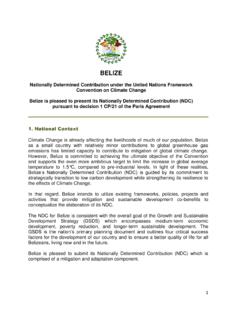Transcription of FORESIGHT - hse.gov.uk
1 1H2 ANNUAL REPORT 2017/18 ENERGYFORESIGHT2 ContentsAABCDEFGBBPAGE 6- 7 Decarbonisation of HeatPAGE 3 ForewordPAGE 4 About this Edition - ENERGYD ecommissioningPAGE 8-9 Transport InnovationsPAGE 10-11 energy StorageTransition to HydrogenSmart Grid TechnologiesOffshore Wind PowerHealth and Safety Round-upPAGE 18-19 PAGE 12-13 PAGE 14-15 PAGE 16-17 PAGE 203 ForewordH21 year we shared our first FORESIGHT Annual Report focussing on the topic of Information and Communication Technologies, which we hope prompted thinking about the impacts of developments in this area on the future world of work. Futures and horizon scanning exercises are not intended to predict the future, but to challenge all of us to review our assumptions about the way things may develop and to consider the potential impact on our strategies and plans as a consequence.
2 This year HSE s FORESIGHT Centre looks at the developments that may be coming in the UK s approach to the generation, storage and use of energy . This is a timely consideration given the priority of reducing the carbon dependency of the UK s energy supply and also the changing split of consumption between industry sectors. Transportation is the largest sector for UK energy consumption1 (at 40% in 2016), and developments in hybrid, electrical and hydrogen energy sources for vehicles will be critical in meeting the Climate Change Act (2008) targets. However, changes in energy consumption and the power generation mix could also be critical and have dramatic impacts on the world of work. By challenging our assumptions at an early stage, potential risks can be understood and minimised or mitigated.
3 This approach is at the core of HSE being an enabling regulator, allowing us to engage early in the development of technologies and to be fit for the future. I hope you enjoy our FORESIGHT Report for 2017/18, and that it helps to stimulate some helpful conversations about the future world of work. Professor Andrew Curran Chief Scientific Adviser and Director of Research4 About this Edition - ENERGY2 government s Chief Scientific Adviser defines horizon scanning as, A systematic examination of information to identify potential threats, risks, emerging issues and opportunities, beyond the Parliamentary term, allowing for better preparedness and the incorporation of mitigation and exploitation into the policy-making process. Futures techniques do not predict the future, but rather they provide decision-makers with the opportunity to build resilience to the changing future occupational landscape.
4 This aligns with the government s aim to help businesses grow and to do so in a safe and productive way. How to Use This ReportThe reader can use this as a discussion document to build up a picture of what their working future might look like and consider the So What? question what might these potential changes mean for health and safety in your area(s) of interest? If you are interested in exploring collaborative futures techniques, such as workshops and scenario building, you can contact the HSE FORESIGHT Centre (please see back cover).in nature, subject to factors such as the weather, which is changeable. This is driving forward advances in energy storage technologies, to store surplus energy and make it available when needed. A number of network firsts were witnessed in 2017 including a day where the UK s electricity system was operated with zero coal-power generation and a day where over half of the country s electricity demand was met by renewable generation.
5 The topics for this report were chosen at a workshop between HSE s FORESIGHT Centre and colleagues from policy, operational and research backgrounds. Emerging trends were selected that are anticipated to take place in the energy system over the coming four to ten years. It builds on HSE s previous work related to emerging energy technologies2. The report contains a collection of thought-provoking articles about emerging energy topics and their potential impact on occupational health and safety. We have not attempted to cover every aspect of energy and there are inevitably overlaps between the HSE s FORESIGHT CentreThe health and safety system in Great Britain aims to ensure that risks in the changing workplace are properly controlled. One of the six strategic themes in the Help Great Britain Work Well3 Strategy (2016) is Keeping Pace With Change4: anticipating and tackling new health and safety challenges.
6 HSE s FORESIGHT Centre undertakes futures activities that contribute to the strategic themes. We identify and analyse trends and emerging issues and consider their potential to affect health and safety. When HSE s futures capability is combined with its unrivalled knowledge and expertise of health and safety, it can help Great Britain to tackle the anticipated problems of tomorrow, to the second annual report from the HSE FORESIGHT Centre. We have chosen energy as a key theme with which to demonstrate the importance of considering future risks and the world of work. energy includes the sources, systems and technologies that relate to power, heat and transport sectors. Environmental targets are driving significant changes in the level and nature of demand for energy in the UK.
7 This is leading to an energy revolution as we transition to a cleaner, low-carbon energy system. energy systems are changing and becoming increasingly complex and interconnected. Over the next ten years the UK energy landscape will look and feel very different from today. The Climate Change Act 2008 sets out the UK s carbon reduction requirements, to reduce emissions by 80% of 1990 levels by 2050. It requires that emissions of carbon dioxide and other greenhouse gases are reduced and that preparations are made for climate change risks. This is supported by the Paris Agreement, a pledge by many nations, including the UK, to hold the global temperature rise at a maximum of two degrees centigrade. The Government is making innovation funding available to support the required transition to a low-carbon future by enabling power, heat and some transport to move away from burning fossil fuels, such as oil and gas, for energy .
8 Enabling technologies, particularly developments in computing, are also driving significant changes in the sector, such as the smart grid. One example of change taking place to decarbonise the energy system is a significant increase in the use of low-carbon electricity to power heating and vehicles. The pressure to decarbonise the energy system is also driving increasing deployment of renewable technologies such as wind and solar power. Renewable energy tends to be intermittent 5H26 DECARBONISATION OF HEATA ccelerating AdvancesNearly half of the energy consumed in the UK is used to provide heat. Seventy percent of the heat generated in the UK comes from burning natural gas, which produces carbon dioxide on combustion. The remainder is generated from electric heating and non-gas fuels such as oil, solid fuel, bioenergy and recycled waste energy .
9 Reducing the carbon content of heat, known as decarbonisation, is required to meet UK carbon reduction targets. Transition to low-carbon alternative energy sources must be achieved in a way that ensures security of supply and affordability for consumers. It is likely that this transition will have a significant disruptive impact on ageing gas and electricity networks. In addition to this, new infrastructures will need to be developed, as well as new policies/regulations, to enable a smooth transition. The energy industry is considering a range of options to achieve decarbonisation. The solutions are likely to be complex and interdependent and will need to be considered at local, regional and national levels. How each option evolves will be influenced by factors such as cost, levels of disruption, consumer acceptance, government support/investment, political will and possible technical advances.
10 It is therefore likely that a mixture of options will be needed to deal with the diverse range of environments, including variations in geography, housing types, habitation patterns and socioeconomic factors. For example, centralised district heating may be more suited to high density areas, whereas localised ground-source heat pumps may be more suited to rural of Heat - involves switching from natural gas to electricity for heating buildings. In this option, gas boilers would be replaced with highly efficient heat pumps (ground and air-source); low temperature radiators and underfloor heating would need to be installed. Heat pumps are already in operation in the UK but uptake has been limited (20,000 installed per annum). Hybrid gas/electric heat pump systems are also an option, allowing customers to switch between fuels, thus providing a back-up system.
















